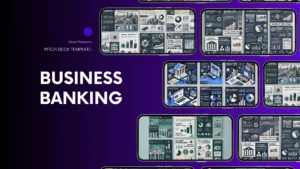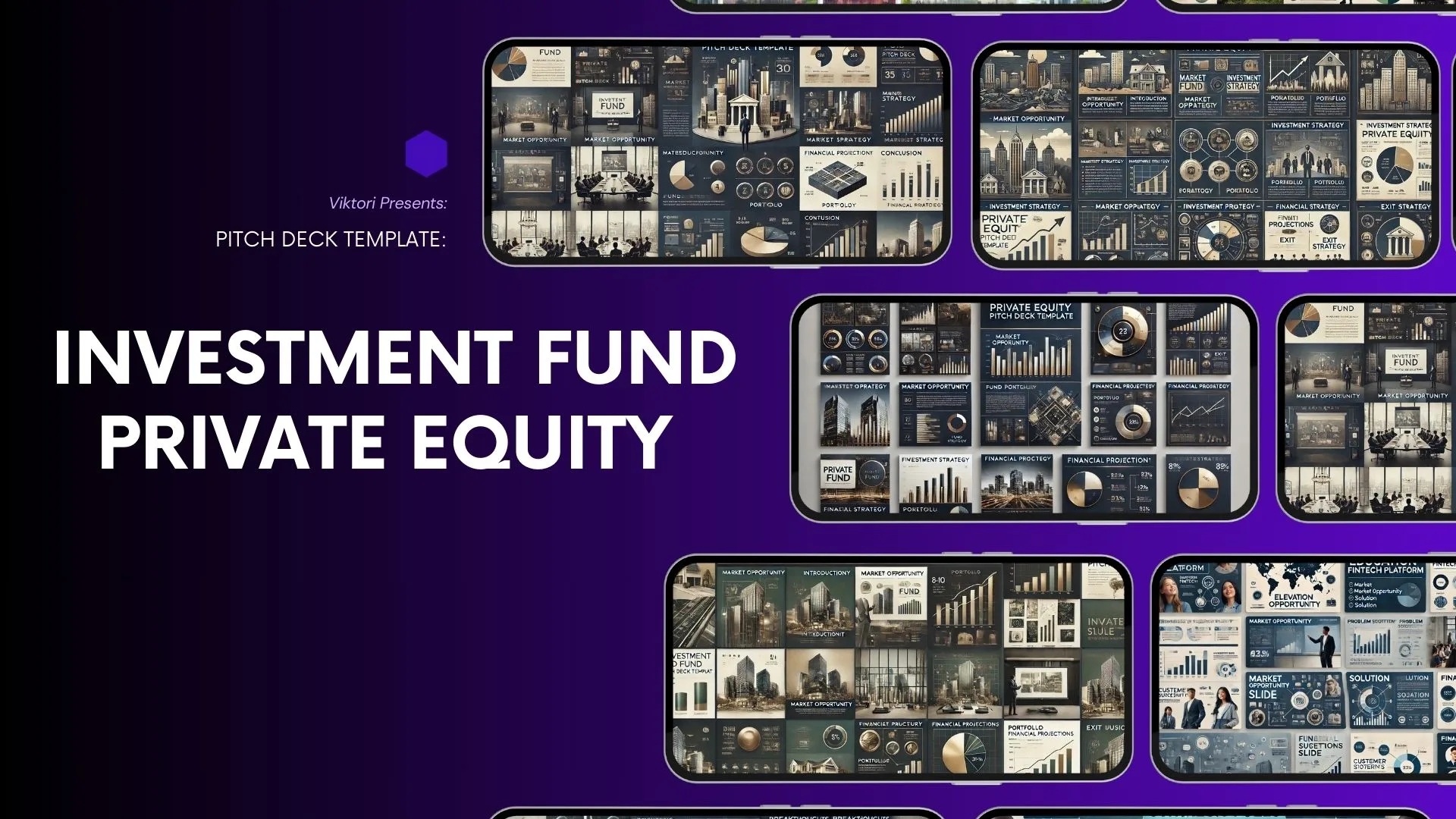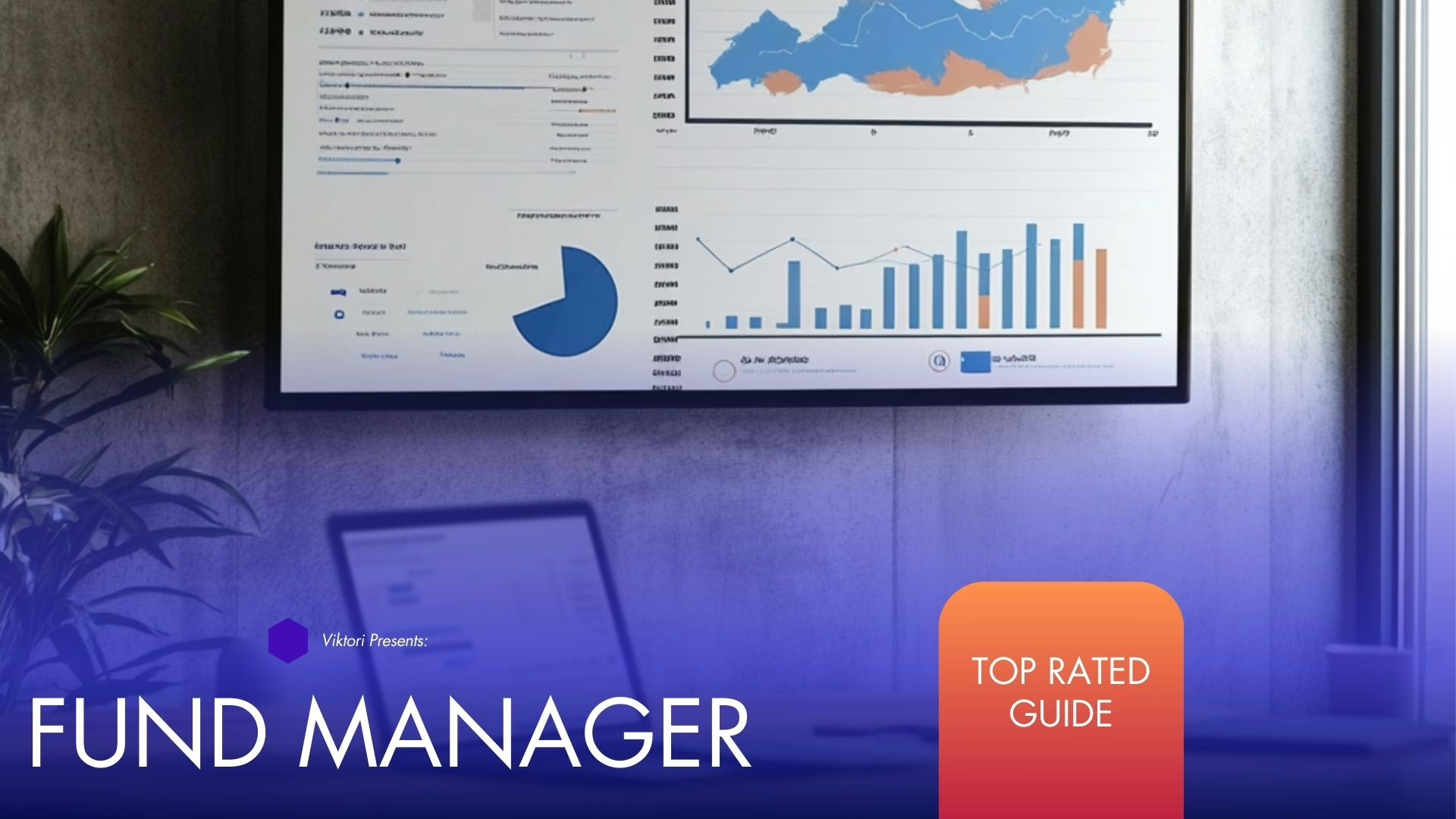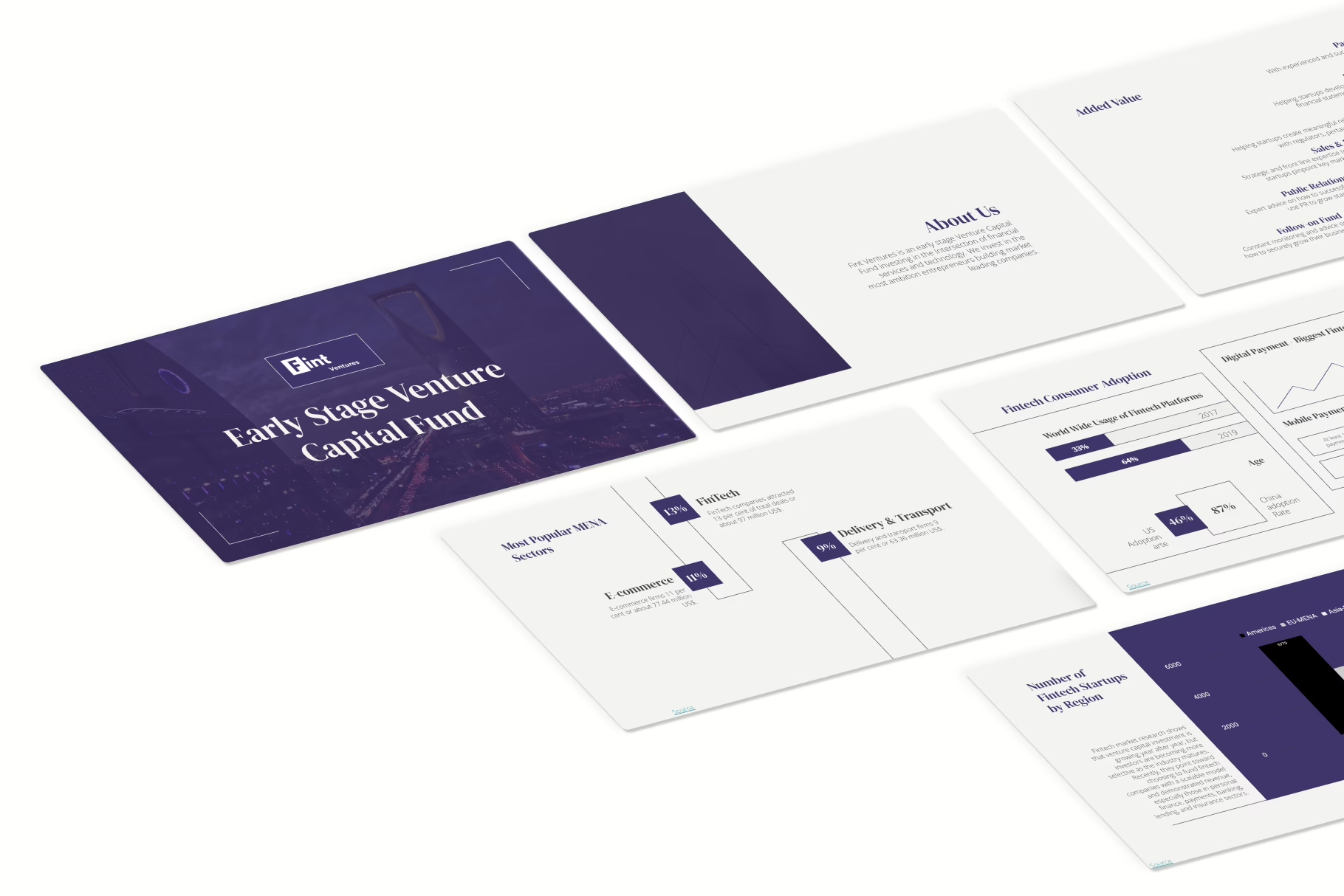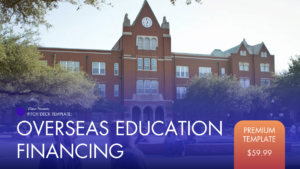
5 Step Guide To Build an Investment Fund Pitch Deck

Author: Viktor
Investment Fund Pitch Deck Expert. Ex Advertising. Founder of Viktori. $500mill In Funding. Bald Since 2010.
You’re here because you’ve decided to dip your toes (or cannonball) into the world of private equity investment funds, and let me tell you—you’ve got guts. But here’s the kicker: your fund isn’t going to sell itself, no matter how much you love quoting “build it and they will come.” Spoiler alert: They won’t.
The cold, hard truth? Your investment fund pitch deck is the real MVP—or at least, it should be. Without one that’s razor-sharp, persuasive, and visually killer, you’re as likely to attract investors as I am to run a marathon (spoiler: not happening). But worry not, because you’ve got me—your no-nonsense guide to crafting the ultimate private equity pitch deck that says “I mean business,” minus the corporate snooze-fest.
Hi, I’m Viktor, your pitch deck expert, strategy wizard, and all-around connoisseur of strong coffee and weak alibis. I’ve spent over a decade building pitch decks that have reeled in checks notes over $500 million for clients. Along the way, I’ve seen every pitfall, rookie mistake, and “we can totally wing it” disaster (spoiler: you can’t). So yeah, I’ve got your back.
In this guide, we’ll cover everything you need to know about private equity pitch decks:
- What they are (and what they’re not—looking at you, glorified PowerPoint).
- 5 easy-to-follow steps to build one that actually works.
- Real-world examples and templates that scream “professional” without looking cookie-cutter.
By the end of this, you’ll not only know how to create a pitch deck but how to create the pitch deck—the kind that makes investors sit up, take notice, and reach for their checkbooks. Ready to start? Let’s dive in.
What is an Investment Fund Private Equity Pitch Deck?
An Investment Fund Private Equity (PE) pitch deck is your golden ticket to securing capital, partnerships, or buy-in from investors who are looking for serious returns. Think of it as a visually compelling, high-impact sales presentation designed to convince potential investors that your fund is the next big thing in the world of high-stakes investing.
At its core, this type of pitch deck doesn’t just sell an idea—it sells confidence. Confidence that you’ve identified a lucrative opportunity, that your team has the expertise to execute, and that you can deliver the kind of returns private equity investors dream about. It’s both a tool for persuasion and a roadmap that lays out exactly how your fund will operate, grow, and succeed.
Why is a Pitch Deck Essential for Investment Fund Private Equity?
A pitch deck isn’t just a “nice-to-have” in private equity—it’s the linchpin for successfully navigating high-stakes interactions with investors, buyers, and stakeholders. In an industry where decisions hinge on confidence, strategy, and results, your pitch deck serves as the ultimate tool to articulate your fund’s value and potential.
Here’s why it’s indispensable:
1. Securing Funding from Investors
The competition for capital is fierce. A polished pitch deck helps you stand out by presenting your investment fund’s thesis, strategy, and potential returns in a way that resonates with institutional and private investors alike.
- 75% of investors prefer presentations with clear, visual storytelling, as reported by a Pitchbook study. A well-designed deck captures attention and holds it, while a clunky one risks losing your audience in minutes.
- It provides a structured narrative that answers the key questions investors have: What’s the opportunity? Why now? How will their capital be deployed and multiplied?
2. Presenting Deals to Potential Buyers
In private equity, deals are made (or broken) by how effectively you can communicate your fund’s vision. A compelling pitch deck is the bridge between identifying an opportunity and getting buy-in from potential buyers or partners.
- It showcases the fund’s alignment with buyers’ goals, whether it’s operational improvement, market expansion, or scaling portfolio companies for exit.
- Visual aids like ROI charts, growth metrics, and strategic roadmaps allow buyers to quickly grasp the big picture while giving them confidence in your execution plan.
3. Building Trust and Credibility with Stakeholders
Trust is the cornerstone of any successful private equity deal. A professional pitch deck establishes your fund’s credibility by demonstrating that you’ve done your homework, understand the market, and have a concrete plan to deliver results.
- Investors and stakeholders want to see more than optimism—they want data-backed projections, a track record of success, and transparency about risks and mitigation strategies. A robust pitch deck delivers this in spades.
- According to research, 78% of decision-makers agree that a clear and concise presentation increases trust in the presenter. For private equity professionals, this trust can translate directly into checks written and partnerships formed.
The Bottom Line
In private equity, your pitch deck is your first impression—and often your only chance to make one. It’s not just a sales tool; it’s a strategic asset that secures funding, builds relationships, and drives deals forward. Without it, you’re essentially walking into a battlefield unarmed. With it, you’re poised to win over even the most discerning investors and stakeholders.
Step-by-Step Guide to Creating a Winning Investment Fund Private Equity Pitch Presentation
Step 1: Define Your Objective
Before diving into your pitch deck, it’s crucial to pinpoint your primary goal. In the realm of private equity, objectives can vary widely, and tailoring your presentation to your specific aim will enhance its effectiveness. Here are some common objectives:
Securing Investment: Attracting capital from institutional investors, high-net-worth individuals, or family offices to fund acquisitions or growth initiatives.
Forming Strategic Partnerships: Collaborating with other firms or industry players to leverage synergies, share risks, or enter new markets.
Management Buyouts (MBOs): Facilitating the purchase of a company by its existing management team, often with the backing of private equity funding.
Leveraged Buyouts (LBOs): Acquiring a company primarily through borrowed funds, using the company’s assets as collateral.
Distressed Asset Acquisitions: Investing in or purchasing companies facing financial difficulties, with the intent to restructure and turn them around.
Growth Capital Investments: Providing capital to mature companies looking to expand or restructure operations, enter new markets, or finance significant acquisitions without changing control.
Clearly defining your objective will guide the structure and content of your pitch deck, ensuring it aligns with the expectations and interests of your target audience.
Step 2: Know Your Audience
Understanding who you’re pitching to is as important as the content of your pitch. Different investors have varying priorities, risk appetites, and concerns. Here’s how to tailor your approach:
Types of Investors:
Institutional Investors: Such as pension funds, insurance companies, and endowments, typically seeking stable, long-term returns.
High-Net-Worth Individuals (HNWIs): Individuals with substantial personal wealth, often open to higher-risk, higher-reward opportunities.
Family Offices: Private wealth management firms that serve ultra-high-net-worth families, focusing on wealth preservation and growth.
Sovereign Wealth Funds: State-owned investment funds with significant capital, looking for large-scale investment opportunities.
Common Investor Concerns:
Return on Investment (ROI): Expected financial gains relative to the investment.
Market Trends: Current and projected industry dynamics that could impact investment performance.
Risk Assessment: Potential challenges and the strategies in place to mitigate them.
Exit Strategy: Clear plans for how and when investors can realize returns.
Management Team Expertise: Confidence in the team’s ability to execute the business plan.
Regulatory Environment: Understanding of legal and compliance issues that could affect the investment.
By thoroughly researching your potential investors and understanding their specific concerns, you can customize your pitch to address their priorities directly, increasing the likelihood of a successful outcome.
Step 3: Use This 12 Slide Pitch Real Estate Deck Template
This 12 slide pitch deck template is perfectly crafted to fit 80% of all pharma deals. If you need a tailor made template, I left a note on where you can ask for it, below.
Slide 1: Elevator Pitch
Title: Empowering Growth Through Strategic Private Equity Investments
Content:
- Opening Statement (Problem Framing):
- “The private equity landscape is evolving. Businesses in high-growth sectors are undercapitalized and underserved by traditional investors.”
- Solution (What We Do):
- “Our fund bridges this gap by strategically investing in scalable businesses, delivering consistent returns for investors while fostering innovation.”
- Value Proposition:
- “We leverage industry expertise, proprietary deal flow, and an active management approach to unlock untapped potential in middle-market companies.”
- Call to Action:
- “Join us in driving transformational growth and achieving superior returns.”
Visuals:
- A bold headline.
- A visual metaphor, like a bridge symbolizing connection or a growth chart.
If you need more tips on how to build this slide, check out my elevator pitch article.
Slide 2: Investor Highlights
Title: Why Invest With Us?
Content (Key Stats and Differentiators):
- Strong Fund Performance:
- “Achieved 25%+ IRR across previous funds.”
- Established Track Record:
- “$2 billion assets under management with 30+ successful exits.”
- Experienced Leadership:
- “Led by industry veterans with 50+ years of collective experience.”
- Growing Market Opportunity:
- “Targeting high-growth sectors with a $100 billion TAM.”
- Value Creation Expertise:
- “Proven operational strategies to drive EBITDA growth and margin expansion.”
Visuals:
- Infographics or a set of icons highlighting each key point.
Slide 3: Problem Statement
Title: The Market’s Missed Opportunity
Content:
- The Challenge:
- “Middle-market businesses often lack access to the strategic capital and operational support needed to scale effectively.”
- “Traditional funding models are either too risk-averse or fail to address operational challenges.”
- Consequences:
- “Untapped growth potential, under-leveraged market opportunities, and suboptimal outcomes for stakeholders.”
- Supporting Data:
- “75% of middle-market companies face funding constraints, despite contributing 33% of GDP.”
Visuals:
- A diagram showing bottlenecks or an under-utilized market pie chart.
Check out the problem slide article for more tips.
Slide 4: Solution Overview
Title: Bridging the Gap in Private Equity
Content:
- Our Approach:
- “We invest in undercapitalized middle-market companies with strong fundamentals and scalable potential.”
- “Active management to unlock value through operational improvements and strategic growth.”
- How We Create Value:
- “Targeted investments in sectors with high growth trajectories.”
- “Proprietary deal sourcing, rigorous due diligence, and a proven value-add approach.”
- Outcome:
- “Delivering double-digit returns while fostering innovation and economic growth.”
Visuals:
- Before-and-after graphics (e.g., a business transformed from stagnation to growth).
Check out the solution slide article for more tips.
Slide 5: Market Opportunity
Title: A Growing Market Opportunity
Content:
- Total Addressable Market (TAM):
- “$500 billion in investable middle-market companies across North America.”
- Sector Focus:
- “Tech-enabled services, healthcare, and sustainable manufacturing—each growing at 15%+ CAGR.”
- Timing Is Key:
- “Post-pandemic shifts and digital transformations are creating unprecedented opportunities for scalable growth.”
- Supporting Data:
- Include stats or quotes from leading research firms (e.g., McKinsey, Bloomberg).
Visuals:
- Market trend graphs and sector breakdown charts.
Slide 6: Investment Strategy
Title: Our Proven Path to Value Creation
Content:
- Target Identification:
- “Focus on sectors with high growth and market inefficiencies.”
- “Leverage our proprietary sourcing network.”
- Due Diligence:
- “Rigorous analysis of operational, financial, and market dynamics.”
- Value Creation:
- “Active board participation, operational restructuring, and digital transformation.”
- Exit Strategy:
- “Strategic sales, IPOs, or secondary buyouts to maximize returns.”
Visuals:
- Flowchart of the investment lifecycle or timeline highlighting these steps.
Slide 7: Portfolio Highlights
Title: Proven Success Across Diverse Investments
Content:
- Portfolio Overview:
- “30+ investments across high-growth sectors, with an average 3.5x MOIC.”
- Highlighted Deals:
- Tech-Enabled Services:
- “Company A: Transformed from $20M to $100M in revenue in 4 years.”
- Healthcare:
- “Company B: Improved EBITDA margins by 15% through operational efficiencies.”
- Sustainable Manufacturing:
- “Company C: Exit with 5x return within 5 years.”
- Tech-Enabled Services:
- Testimonials:
- “We partnered with [Fund Name] to drive transformation and exceeded our growth targets.”
Visuals:
- Logos of portfolio companies, case study callouts, or a performance chart showing historical returns.
Slide 8: Competitive Advantage
Title: Why Choose Us?
Content:
- Proprietary Deal Flow:
- “Access to exclusive, off-market opportunities through extensive network relationships.”
- Operational Expertise:
- “Hands-on value creation through a team of industry specialists.”
- Risk Mitigation:
- “Robust risk frameworks ensure capital protection and strategic growth.”
- Track Record:
- “Proven ability to deliver outsized returns across market cycles.”
- Market Insight:
- “Deep understanding of emerging trends and agile investment strategies.”
Visuals:
- Venn diagram showcasing competitive advantages or an “edge matrix.”
Slide 9: Team Overview
Title: The Experts Behind the Strategy
Content:
- Leadership Team:
- Brief bios highlighting expertise in private equity, finance, and target sectors.
- Example:
- “John Doe (Managing Partner): 20+ years in private equity, leading $5B+ in transactions.”
- “Jane Smith (Operations Lead): Former COO of a Fortune 500 company with deep operational expertise.”
- Advisory Board:
- “A network of industry veterans supporting strategic decisions.”
Visuals:
- Photos or icons of team members with concise bios.
Slide 10: Financial Projections
Title: Delivering Consistent and Predictable Returns
Content:
- Expected Performance:
- “Target IRR: 20%+; Target MOIC: 3x.”
- “Capital deployed within 3 years, with projected exits in 5-7 years.”
- Revenue Drivers:
- “Organic growth, M&A strategies, and operational efficiencies.”
- Fund Timeline:
- “Year 1: Investment phase.
Year 3: Portfolio optimization.
Year 5-7: Exit phase.”
- “Year 1: Investment phase.
- Illustrative Scenarios:
- Provide sensitivity analysis or scenario modeling to show return profiles under different conditions.
Visuals:
- Bar charts for projected returns and timelines.
Check out the financials slide article for more tips.
Slide 11: Risk Management
Title: Protecting Capital While Driving Growth
Content:
- Diversification Strategy:
- “Investments across multiple industries and geographies to reduce risk.”
- Due Diligence:
- “In-depth financial, operational, and market analysis.”
- Downside Protection:
- “Structured investments with preferred equity and minority protections.”
- Crisis-Resilience:
- “Proven risk management framework ensures stability even in volatile markets.”
Visuals:
- Risk matrix or framework illustration.
Slide 12: Closing Slide
Title: Partner With Us for Transformational Growth
Content:
- Key Takeaways:
- “Our mission is to unlock value, drive innovation, and deliver consistent returns for investors.”
- “A trusted partner with a proven track record of success.”
- Next Steps:
- “Contact us to explore investment opportunities.”
- “Join our network of successful partners.”
- Contact Information:
- Include the fund’s website, email, phone, and LinkedIn.
Visuals:
- Inspirational image (e.g., a growing tree or skyline) with contact details prominently displayed.
Step 4: Design a Professional Pitch Deck
Your pitch deck’s design plays a significant role in capturing attention and conveying professionalism. A well-designed deck ensures your content is visually appealing and easy to follow, leaving a lasting impression on your audience.
Creating a pitch deck from scratch can be time-consuming, but with the right tools and templates, you can streamline the process and ensure a professional result.
Here are some resources to help you get started:
Download a Premade Pitch Deck Presentation Template
- Access ready-made investment fund private equity pitch deck templates designed for various project types, including residential, commercial, and mixed-use developments.
- Each template includes:
- Pre-formatted slides for investor highlights, financials, and location analysis.
- Editable placeholders for property visuals, charts, and project details.
- Instructions for customizing fonts, colors, and layouts to match your branding.
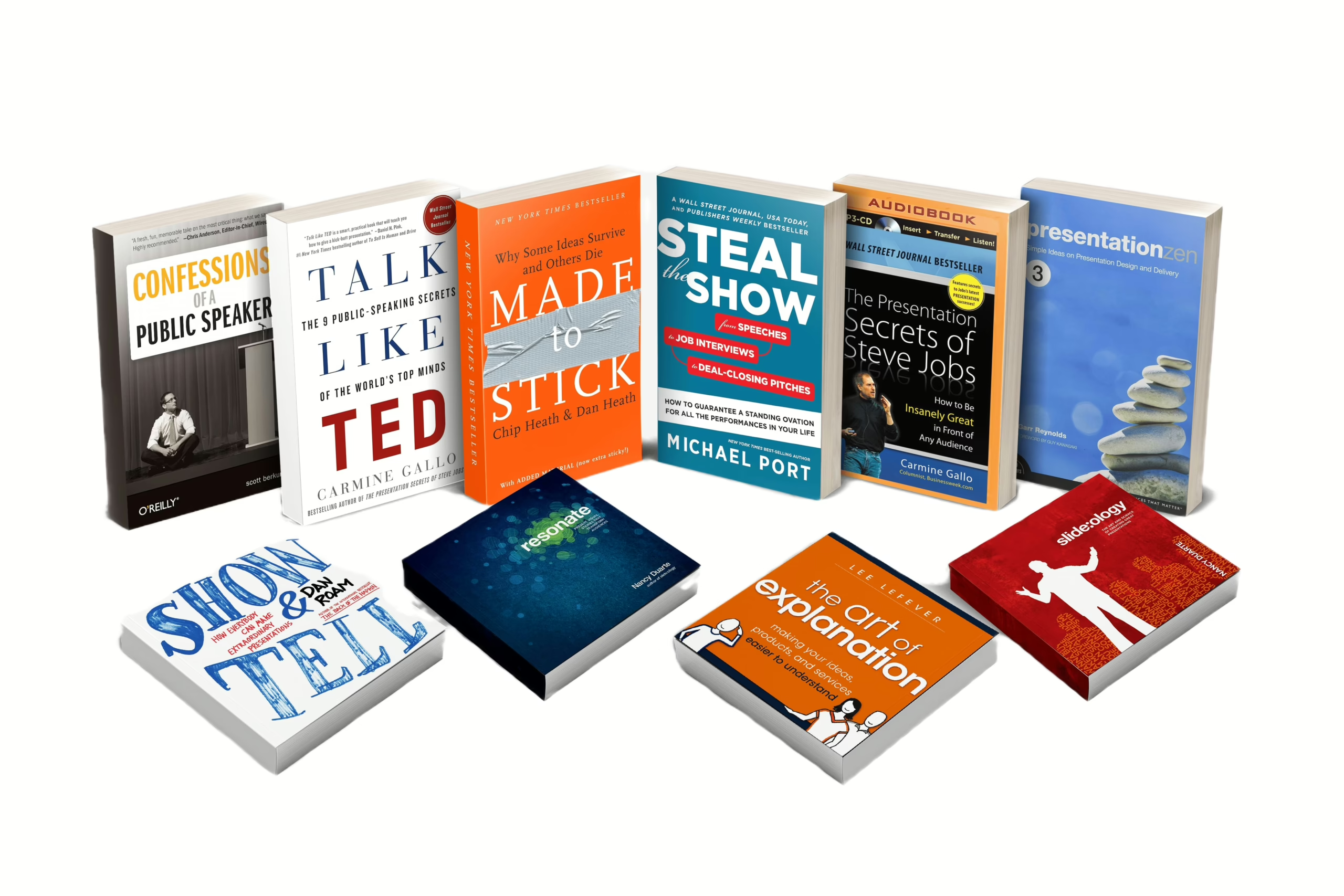
Presentation Books
Must have popular books that 1000s of presenters and CEO's read in order to help them become better at communicating their ideas. Click on the image for the full article.
Recommended Tools for Creating Templates
- Canva: Great for creating visually appealing, customizable templates with ease.
- PowerPoint: A reliable choice for building professional presentations with advanced features like slide animations and data integration.
- Gamma: Ai pitch deck tool that makes a decent presentation if you’re strapped for budget. I wouldn’t recommend this if you’re pitching a project that’s 7 figures +. Check out the Gamma generated deck below.
- Professional Design Services: For high-stakes presentations, consider hiring an investment fund private equity pitch deck expert to create a polished, custom template that reflects your brand’s professionalism.
Tips for Designing a Polished Template
- Use Clean, Consistent Fonts and Colors:
- Select no more than two fonts: one for headings and another for body text.
- Stick to a color palette that aligns with your branding or project theme.
- Avoid overly decorative fonts or clashing colors that distract from your message.
- Incorporate High-Quality Visuals:
- Include property images that showcase your project in the best light.
- Add charts and graphs to present financial data and market trends clearly and concisely.
- Use infographics to simplify complex information, such as timelines, leasing plans, or development phases.
- Maintain Slide Consistency:
- Ensure all slides have aligned text boxes, consistent margins, and matching layouts.
- Use bullet points and icons to break up text-heavy slides for better readability.
Alternatively, book a call and get the full pitch deck done. Hands-off.
I’ll do the copy, design, financials, narrative and give you some go-to-market ideas you can implement. 1000s of founders hired me to do the same. During the process, they saved 40 hours on average.
Step 5: Practice and Refine Your Pitch
Delivering a compelling pitch requires more than just a well-designed deck; it demands practice, refinement, and adaptability. Here are specific tips to enhance your presentation:
Rehearse Thoroughly: Practice your pitch multiple times to build confidence and ensure a smooth delivery. This preparation helps reduce filler words and keeps your presentation concise.
Time Management: Aim for a presentation length that holds attention without rushing. Typically, 15-20 minutes is effective, allowing time for questions.
Seek Constructive Feedback: Present to colleagues or mentors and encourage candid critiques. Use their insights to refine your content and delivery.
Anticipate Questions: Prepare responses to potential questions or objections. This readiness demonstrates your deep understanding of your proposal.
Adapt to Your Audience: Tailor your pitch to the specific interests and knowledge level of your audience. Highlight aspects most relevant to them.
Maintain Authenticity: Be genuine in your delivery. Authenticity fosters trust and engagement with your audience.
Use Visual Aids Wisely: Incorporate visuals to support your narrative but avoid clutter. Ensure all graphics are clear and enhance understanding.
Control Your Pace: Speak at a measured pace to ensure clarity. Pausing after key points allows your audience to absorb information.
Monitor Body Language: Maintain eye contact, use purposeful gestures, and adopt an open posture to convey confidence and engage your audience.
Prepare for Technical Issues: Have backups of your presentation and be ready to continue smoothly in case of technical difficulties.
20 Common Investor Questions and Suggested Responses
What is your investment thesis?
Our investment thesis focuses on identifying undervalued companies in the [specific industry] sector with strong growth potential. We aim to enhance value through strategic operational improvements and market expansion.How do you source potential deals?
We leverage a robust network of industry contacts, attend key industry events, and utilize data-driven market analysis to identify promising investment opportunities.What is your target return on investment (ROI)?
Our target is an internal rate of return (IRR) of [X]% over a [Y]-year investment horizon, aligning with industry benchmarks for similar funds.Can you describe your due diligence process?
Our due diligence involves comprehensive financial analysis, market assessments, management evaluations, and risk assessments to ensure informed investment decisions.What are the main risks associated with your investment strategy?
Key risks include market volatility, regulatory changes, and operational challenges. We mitigate these through diversification, active management, and thorough due diligence.How do you plan to add value to portfolio companies?
We implement strategic initiatives such as operational efficiencies, leadership enhancements, and market expansion to drive growth and profitability.What is your exit strategy for investments?
Our exit strategies include strategic sales, initial public offerings (IPOs), or recapitalizations, chosen based on market conditions and company performance.How do you handle underperforming investments?
We proactively engage with management to identify issues and implement corrective measures, including restructuring or strategic pivots, to improve performance.What is the composition and experience of your management team?
Our team comprises professionals with extensive experience in private equity, investment banking, and industry-specific operations, bringing a wealth of expertise to our fund.How do you align your interests with those of your investors?
We invest our own capital alongside our investors and structure performance-based incentives to ensure alignment of interests.What fees do you charge investors?
Our fee structure includes a management fee of [X]% and a performance fee of [Y]% of profits, consistent with industry standards.Can you provide examples of successful past investments?
Certainly, in our previous fund, we invested in [Company A], where we achieved a [Z]% return through strategic market expansion and operational improvements.How do you stay informed about market trends and industry developments?
We maintain subscriptions to leading industry publications, participate in conferences, and have a dedicated research team analyzing market trends.What is your fund’s investment horizon?
Our typical investment horizon ranges from [X] to [Y] years, depending on the specific opportunity and value creation plan.How do you assess the management teams of potential portfolio companies?
We evaluate management teams based on their track record, industry experience, leadership skills, and alignment with our strategic vision.What is your approach to ESG (Environmental, Social, and Governance) considerations?
We integrate ESG factors into our investment process, recognizing that responsible investing contributes to long-term value creation.How do you manage liquidity within the fund?
We maintain a balance between committed capital and investment opportunities, ensuring sufficient liquidity to meet obligations and capitalize on new opportunities.What differentiates your fund from competitors?
Our unique value proposition lies in our [specific strategy], deep industry expertise, and a proven track record of delivering superior returns.How do you handle conflicts of interest?
We adhere to strict ethical guidelines and have policies in place to identify and manage conflicts, ensuring transparency and fairness for all stakeholders.What is the minimum investment required to participate in your fund?
The minimum investment commitment for our fund is [X] million dollars, designed to align with our investment strategy and target investor profile.
By thoroughly preparing for these questions and refining your pitch delivery, you’ll be well-equipped to engage potential investors effectively and convey the value proposition of your private equity fund.
2 Investment Fund Private Equity Pitch Deck Examples
Real Estate Investment Fund Pitch Deck
Overview: This 16-slide pitch deck is tailored for a real estate investment fund, focusing on strategic property acquisitions and value enhancement.
Key Components:
Fund Structure: Details on fund size, equity and debt structure, and investment duration, providing clarity on financial strategy.
Market Opportunity: Analysis of real estate market trends, identifying lucrative investment opportunities.
Investment Strategy: Clear articulation of property selection criteria and value-add approaches.
Financial Projections: Projected returns, cash flow analyses, and exit strategies, offering transparency to potential investors.
What Makes It Effective:
Clarity and Structure: Each slide presents information logically, making it easy for investors to follow the fund’s strategy.
Data-Driven Insights: Inclusion of market data and financial projections builds investor confidence.
Professional Design: Clean visuals and consistent formatting enhance readability and engagement.
Fund Manager Pitch Deck
Overview: A 13-slide template designed for fund managers to present their investment approach and track record.
Key Components:
Team Introduction: Profiles of key team members, highlighting experience and expertise.
Investment Philosophy: Explanation of the fund’s core investment principles and decision-making process.
Portfolio Highlights: Showcase of successful investments and case studies demonstrating value creation.
Market Analysis: Insights into target markets and sectors, supported by relevant data.
What Makes It Effective:
Emphasis on Team Strength: Showcasing the team’s expertise builds trust with potential investors.
Strategic Focus: Clear articulation of investment philosophy and market focus demonstrates a well-thought-out approach.
Visual Appeal: Professional design elements maintain investor interest and convey professionalism.
Real Estate Pitch Deck Case Study: Fint Ventures
Fint Ventures Pitch Deck: A Revamped Fintech VC Fund Presentation
Context and Challenges
Fint Ventures, a fintech-focused venture capital fund, aimed to attract investors by showcasing its expertise in identifying high-growth opportunities in the rapidly expanding financial technology sector. However, their initial pitch faced several challenges:
- Design: The presentation lacked visual coherence, making it hard to hold audience attention.
- Copy: The narrative failed to effectively communicate the fund’s unique value proposition.
- Research: Insufficient use of market data weakened credibility.
- Narrative: The pitch lacked a compelling storyline, failing to connect with investors.
- Financials: Projections and performance data were unclear and unconvincing.
- Strategy: The overall presentation appeared fragmented and unfocused.
Strategic Solutions Implemented
1. Design Enhancement
- Approach: Reimagined the deck with a modern, professional design that reflects the cutting-edge nature of fintech.
- Solution:
- Used vibrant visuals and data-driven infographics to illustrate key points.
- Incorporated high-resolution images of fintech innovations (e.g., mobile banking, blockchain technology).
- Adopted a consistent color palette and modern typography.
- Example: A bold title slide featuring an animated representation of digital transactions and Fint Ventures’ tagline: “Fueling the Future of Fintech.”
2. Compelling Copy Development
- Approach: Created concise, engaging messaging that emphasized the fund’s expertise and unique positioning in the fintech sector.
- Solution:
- Highlighted Fint Ventures’ mission to empower fintech startups disrupting traditional finance.
- Articulated how their track record and network provide a competitive edge.
- Example: “At Fint Ventures, we identify and back the fintech disruptors reshaping global financial landscapes—delivering value for innovators and investors alike.”
3. In-Depth Research Integration
- Approach: Integrated comprehensive market research to substantiate the fund’s claims and showcase opportunity areas.
- Solution:
- Presented statistics like fintech market size growth (e.g., CAGR of 25%+) and sectors experiencing rapid adoption (e.g., embedded finance, decentralized finance).
- Included expert insights and benchmarks from credible industry sources (e.g., McKinsey, CB Insights).
- Example: “By 2030, global fintech revenues are projected to exceed $500 billion, driven by advancements in AI, blockchain, and financial inclusion technologies.”
4. Narrative Structuring
- Approach: Organized the deck into a cohesive, investor-centric story.
- Solution:
- Structured the narrative to flow seamlessly from problem identification to Fint Ventures’ solution.
- Showcased the journey from fund inception to proven results.
- Example: Storyline: “The Problem: Traditional Finance Fails to Innovate → The Opportunity: Fintech to Bridge the Gap → The Solution: Fint Ventures’ Vision and Strategy.”
5. Financials Presentation
- Approach: Simplified and clarified financial data to increase accessibility and highlight potential returns.
- Solution:
- Used clean graphs and tables to present historical fund performance, IRRs, and projected fund returns.
- Emphasized how Fint Ventures mitigates risks and maximizes ROI for investors.
- Example: “Historical Fund Performance: 30% IRR, 3.5x MOIC over a 7-year horizon, driven by strategic investments in early-stage fintech unicorns.”
6. Strategic Business Presentation
- Approach: Clearly articulated Fint Ventures’ business model and competitive advantage.
- Solution:
- Emphasized a strong network of fintech experts, proprietary deal flow, and a disciplined investment approach.
- Highlighted the fund’s active involvement in portfolio companies to scale their operations.
- Example: “Our partnerships with global banks and fintech accelerators enable unparalleled access to the best deals and innovative startups.”
Outcome
With these enhancements, Fint Ventures is now positioned as a leading fintech VC fund that not only offers superior returns but also drives the transformation of financial ecosystems. This revamped pitch demonstrates expertise across design, narrative, research, and financial strategy, ensuring investors view Fint Ventures as a compelling, high-potential investment opportunity.
FAQ
1. What is the main objective of an investment fund private equity pitch deck?
The primary objective is to secure funding, partnerships, or buy-in by clearly presenting your fund’s strategy, investment thesis, and potential returns. It should communicate value and build confidence among potential investors.
2. What key elements should be included in a private equity pitch deck?
A well-rounded deck should have:
- Executive Summary
- Problem/Opportunity Statement
- Investment Thesis
- Market Analysis
- Portfolio Strategy
- Financial Projections
- Team Overview
- Exit Strategies
- The Ask (specific funding requirements)
- Closing Slide with Call to Action
3. Who is the target audience for a private equity pitch deck?
The target audience includes institutional investors, high-net-worth individuals (HNWIs), family offices, sovereign wealth funds, and sometimes strategic partners or corporate buyers.
4. How long should the pitch deck presentation take?
An effective presentation should last 15–20 minutes, leaving ample time for questions. The pitch deck itself should be concise, ideally no more than 15–20 slides.
5. How do you tailor a pitch deck to specific investors?
Customize the content to align with the audience’s priorities. For example:
- Institutional investors may focus on risk management and regulatory compliance.
- HNWIs may look for high growth and strong returns.
- Family offices often prioritize wealth preservation and long-term gains.
6. What makes an investment thesis compelling?
A compelling investment thesis:
- Clearly defines the market opportunity and inefficiencies.
- Demonstrates how the fund will generate superior returns.
- Includes a data-driven narrative supported by trends and statistics.
7. What financial details are investors looking for in the deck?
Investors want to see:
- Projected internal rate of return (IRR)
- Cash-on-cash multiples
- Fund size and allocation breakdown
- Exit strategies and timelines
- Risk mitigation strategies
8. How can I present past performance effectively in the deck?
Highlight case studies of successful investments, including:
- Acquisition cost
- Value-added improvements
- Exit multiples and realized returns
Use visuals like graphs, tables, and before/after comparisons for clarity.
9. What are common mistakes to avoid in a private equity pitch deck?
- Overloading slides with text or data.
- Using jargon or overly technical language.
- Failing to address risks and mitigation strategies.
- Neglecting a clear “ask” slide detailing investment needs and allocation.
10. How often should a pitch deck be updated?
Regularly update your deck to reflect:
- Changes in market conditions or strategy.
- New financial data or performance metrics.
- Feedback from past investor presentations.
A dynamic, up-to-date deck shows preparedness and responsiveness.
Book a call and get the full pitch deck done. Hands-off.
I’ll do the copy, design, financials, narrative and give you some go-to-market ideas you can implement. 1000s of founders hired me to do the same. During the process, they saved 40 hours on average.
Related fund pitch deck resources

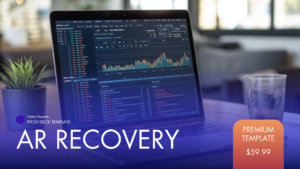

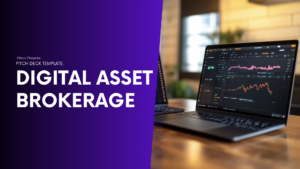
14 Slide Digital Asset Brokerage Pitch Deck Template | Google Slides

